Abstract
The indoor climate of non-climatized churches is usually subject to cyclical fluctuations of temperature and relative humidity induced by external climate conditions which might be dampened by the high thermal capacity of their envelope. However, several phenomena affect their indoor climate (e.g., internal gains due to people and artificial lighting, air infiltration, etc.), which lead to environmental variations that might jeopardize the artworks contained within. In particular, one of the most influential parameters that may affect non-climatized churches is the massive and intermittent presence of people who constantly visit their spaces. In such regard, long-term monitoring allows the collection of environmental data with different building operation conditions and visitor fluxes. This paper analyses the indoor climate of the Milan Cathedral (Duomo di Milano) in Italy for three continuous years (including the lockdown period that occurred in 2020 caused by the COVID-19 pandemic), with a focus on visitors’ effects on the indoor environment and the conservation of the main artworks contained within. The results of the analysis have shown that spaces with huge volume are most influenced by the opening of the doors rather than the hygrothermal contribution of the intermittent presence of massive crowds. Moreover, the absence of visitors for a prolonged period correlates with an improvement in the indoor conservation conditions for artworks, especially those made of hygroscopic materials, due to the reduction in short, rapid climate fluctuations.
1. Introduction
Italian churches, crypts, monastic complexes, abbeys, etc. represent an invaluable part of the existing building stock that must be properly preserved for future generations, since they contribute to the identity, society and cultural values of a country [1,2].
The need for protecting cultural heritage and strengthening its preservation-related issues has been also explicitly stated by the UN Agenda 2030 and Sustainable Development Goals (SDGs) [3].
Such built heritage, generally, contains artworks that might be particularly susceptible to temperature (T) and relative humidity (RH) variations [4,5,6]. According to different standards [7,8,9,10] and the scientific literature [1,2,11,12,13,14,15], valuable materials and artworks can be endangered by specific climate hygrothermal variations which induce phenomena such as cyclic dissolution and recrystallization of soluble salts, desiccation, warping and flacking, biological and chemical decay, etc.
These aspects are particularly relevant in non-climatized churches (i.e., not provided with an HVAC system), whose indoor climate is usually subjected to cyclical temperature and humidity fluctuations induced by external conditions. It is well known that high daily peaks in those parameters might jeopardize the conservation of materials. Moreover, several other phenomena could affect the indoor climate (such as visitor influx, artificial lighting, air infiltration, etc.) [16,17,18,19] which can induce alterations that endanger the preservation conditions. Moreover, often it is difficult to distinguish and record the specific effect that any one phenomenon has on the indoor environment with respect to the others.
Since people release humidity and heat from their bodies, exhale CO2 and transport pollutants, they involuntarily unbalance the indoor climate of the buildings they visit [18,20,21]. Because of this direct changing effect on indoor hygrothermal conditions, their permanence might jeopardize the conservation of artworks contained within [22].
Therefore, the impact of massive numbers of visitors on cultural heritage could have a great impact on these buildings. In the last decades, such topic received the attention of the scientific community [23,24], especially with the diffusion of the COVID-19 pandemic [19,25,26,27,28].
In such regard, long-term environmental monitoring is pivotal to assess the conservation conditions of these buildings, since it allows us to evaluate how people can affect the indoor climate of a huge volume and ancient historic building. Moreover, in the current scenario of rapid climate change and the progressive intensification of extreme events (e.g., heat waves, floods, etc.), [29] is of particular interest to continuously monitor the internal conditions of historic buildings, particularly those without an HVAC system [19,30].
Past studies dealing with the impact that visitors have on the indoor climate of some non-climatized historic buildings have shown a significant correlation between an influx of people and the alteration of temperature and humidity levels of indoor spaces [20,31,32].
For instance, Camuffo et al. [33] analysed the impact of people inside the Hall of the Giants in the Carrara Palace of Padua (Italy), showing that an increase in air temperature caused by the presence of people, leads to an initial decrease in relative humidity, which is soon counteracted by the increase of water vapour produced by people.
Other studies focusing on public spaces such as exhibition halls have shown that these environments, generally characterized by relatively small spaces, are strongly subjected to the hygrothermal contribution caused by the presence of people [4,34]. It is well known that high and rapid changes in relative humidity could cause mechanical degradation (e.g., cracks, differential expansion/contraction stress which leads to lifting of veneers, deformations, loss, etc.) in hygroscopic materials, such as wood, paintings, paper, etc., that generally can be found in religious buildings, and could also cause efflorescence and swelling on plastered surfaces [35]. In this sense, hygrothermal monitoring within these spaces represents a pivotal activity to keep these fluctuations within certain conservation ranges. For example, as suggested by EN 15757 [36], the target range for RH fluctuations is determined as the 7th and 93rd percentiles of the fluctuations recorded for a monitoring period of at least one year.
An adequate strategy to counteract the impact of people’s presence on the indoor environment which hosts susceptible collections is to adequately manage their flux and provide suitable heating, ventilation and air conditioning (HVAC) systems [19].
Silva et al. carried out a monitoring campaign on the Monastery of Jerónimos in Portugal [19], showing that the increasing number of tourists influences negatively the hosted artworks, in particular causing risks of mould germination and irreversible deformations on painted panels. They also simulated future scenarios with different rates of visitors, since no HVAC systems for climate control can be installed, and suggested better management of visitor entries [19]. Although in some cases the presence of visitors is deleterious to the artworks (due to the impact on the microclimate), in other cases, even if indirectly, people with their presence cause noise and allow a minimum of cleanliness that prevents some insects from acting undisturbed (e.g., silverfish), reducing the damage risks for artefacts such as books, papers and other organic materials [37,38].
A. H. Zaki et al., through a computational fluid dynamic (CFD) study [39] on King Tutankhamen’s gallery located in the northern part of the Egyptian Museum, show that, in the winter season, when the gallery is naturally ventilated, the warm air due to visitors’ presence circulates through the upper part of the volume, replaced by the fresh air coming from the windows.
Similarly, Balocco et al. analysed the impact of people walking inside an important library in Parma (Italy) using CFD [40]. They highlight that the additional sensible and latent heat released by visitors is not particularly dependent on the standing or moving conditions; however, their movement represents a key aspect with regard to the potential transport of particles and pollutants, which is of particular importance for cultural heritage conservation and maintenance.
Varas-Muriel and Fort, in a monitoring campaign carried out between 2012 and 2013 for a historic church located in Algete (Spain) [41], showed that people affect the local indoor climate conditions depending on their location, with the peaks of variation after 1–1.5 h of human occupancy. Moreover, the authors point out that the environment undergoes differential thermal heating in larger churches, depending on the area where people are concentrated during services and cause a slight concentric stratification on the indoor environmental conditions, both vertically and horizontally, around the congregation and up to a height of 3 m. The conservation of the artworks hosted inside this church can be influenced by these conditions [41].
The indoor climate analysis carried out by Grzegorz Nawalany et al. in an unheated smaller wooden church located in Ptaszkowa (Poland) [25], has detected temporary high fluctuations of air temperature and relative humidity during the services due to a large number of worshippers with respect to the small volume of the building. Such impact is later mitigated by the external conditions in a few hours after the services. The authors highlight that the susceptibility of the indoor climate depends also on the small thermal capacity of the church’s envelope. Thus, this paper aims to analyse the impact that visitor influxes have on the microclimate of the Milan Cathedral in Italy, which is one of the greatest non-climatized cathedrals in Europe, with a particular focus on the conservation of the main artworks hosted within.
In this respect, an extensive monitoring campaign allowed the collection and comparison of environmental data during the standard building operation (generally characterized by a high number of tourists) and during the lockdown caused by the COVID-19 pandemic, when the influx of visitors was stopped abruptly for a prolonged time [19]. The microclimatic data acquired during such period allow to analyse how the absence of visitors might affect the indoor climate of a huge, non-climatized religious building in Italy. The results presented can therefore provide a better understanding of the behaviour of such huge buildings in order to guarantee their long-term conservation. This research thus further increases the scientific knowledge on such topic, on the basis of experimental data acquired in the field. The present work represents a prosecution of a previous research developed for the same case study [42].
This work is organized as follows: Section 2 describes the case study; Section 3 describes the method adopted in the current research; Section 4 shows the results and discussion about the analysed climate variables (temperature and relative humidity) continuously monitored for three years and the main effects of visitor flux on the indoor climate, and discusses their impact on the materials’ conservation. Finally, the conclusions and derived suggestions are outlined in Section 5.
2. Case Study
The case study analysed in this work is one of the most prominent architectural examples in the Italian cultural heritage scenario: the Milan Cathedral. This building is characterized by a net indoor area and volume of about 8500 m2 and 300,000 m3, respectively. The internal heights of the lateral and central naves vary from about 20 m to 45 m respectively, while the cupola reaches up to 65 m. Its opaque envelope is made of masonry walls of variable thicknesses, while the roof has a double system of overlapping brick vaults that generates accessible attic spaces which are directly connected with the interior of the cathedral through numerous ventilation holes. The transparent surfaces include over 50 stained glass windows, decorated with the grisaille painting technique. Natural ventilation is managed during the year through the doors and some windows located in the ambulatory and the transept [42].
In addition, the Cathedral hosts numerous artworks of various ages and materials [35], such as marble sculptures and decorations, wooden benches, confessionals, large painted panels, etc. and numerous artefacts contained in the altars of the aisles.
Among the noteworthy objects, the organs are the most complex, susceptible and important in terms of conservation. The Cathedral hosts a number of different organs in the altar area, as shown in Figure 1. Among these, the Organo Maggiore with its 15,800 pipes is the biggest organ in Italy [43,44] and represents an absolute exceptionality both from an artistic and musical point of view. This magnificent artefact is made of four cases in carved wood, located between the choir and the apse over the wooden stalls of the presbytery. In addition, each ancient case is enclosed by four panels, which have a pair of canvases representing episodes from the Old and New Testaments [45], as shown in Figure 1.
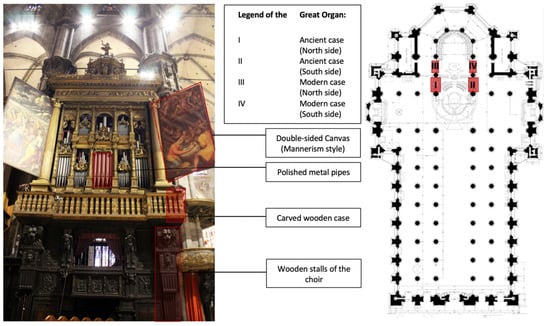
Figure 1.
The Organo Maggiore with its main elements (left); the plan of the Milan Cathedral with the location of the musical instruments (right).
3. Method
The method adopted in the current research is based on the following 3 steps: in the first one, the main data related to the indoor climate parameters are monitored in different years; after that, the impact due to the visitor influx on such parameters is evaluated and, finally, the assessment to identify possible risk for material conservation is carried out. A flowchart with the method adopted is shown in Figure 2 and a detailed description of each phase is reported hereafter.
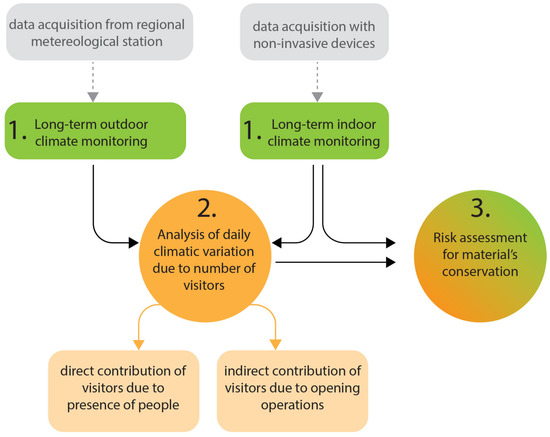
Figure 2.
Flowchart of the method adopted.
3.1. Strategy for Indoor Climate Monitoring
The long-term monitoring of the indoor climate in Milan Cathedral aims to characterize the hygrothermal behaviour of the building allowing the detection of possible risk conditions for the conservation of the material finishing and artworks contained within.
In such regard, in this work, data were collected for three consecutive years (2019, 2020 and 2021). The data acquisition was performed by means of non-invasive methodology and instruments (datalogger), positioned at relevant points and able to store the information collected, in order to keep the finishes and artefacts intact and to ensure the smooth running of the activities inside the Duomo [42].
The dataloggers installed are model HOBO MX1101, which has an accuracy of ±0.21 °C (from 0 °C to 50 °C) for temperature and ±2% (from 20% to 80%) for relative humidity.
In order to evaluate the reliability of the data collected over multiple years, three indexes have been calculated: the Completeness Index (CoI), the Continuity Index (CI) and the Microclimatic Quality Index (MQI) according to [46].
In detail, the CoI was used to establish a period in which there is at least one year of continuous observations with a reduced number of missing values. It is calculated through the ratio between the number of valid data and the total number of recordings in one year. The CI index provides the reliability of a series taking into account the number of intervals with missing data with respect to the total number of collected data. Finally, the MQI index was calculated to assess the quality of the time series based on the accuracy of the instruments adopted and the length of the data collected [46]. All three indexes range from 0 (poor quality) to 1 (high quality) [47].
According to the data analysed and shown in Table 1 for all the six dataloggers, the statistical indexes are for most of the years equal to unity, except for datalogger S2 which misses some days in June 2020.

Table 1.
Main information on the dataloggers adopted for the monitoring campaign.
Such instruments started to collect data in 2018 after the replacement of the previous dataloggers to obtain greater flexibility in changing the batteries and collecting the data. In Figure 3 is shown the location of the six dataloggers installed, which were numbered from S1 to S6. The location of the six dataloggers was defined in order to collect environmental data from different areas distributed within the Cathedral. Some common aspects considered for the location are: accessibility and non-interference with visitors, allowing the collection of climatic data at different depths and heights within the Cathedral, and proximity to some artworks and objects that must be preserved.
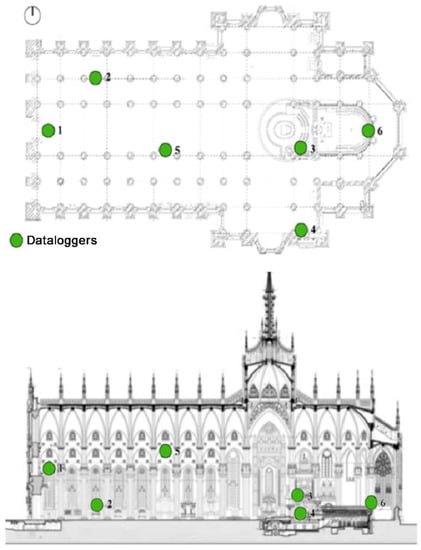
Figure 3.
Location of the six dataloggers distributed in the indoor space of the Cathedral.
It should be noted that although limited in number, the sensors placed allow for a quite representative overview of the interior space, since, as was found through a point survey carried out in a previous campaign [42], the environmental differences within the cathedral are not excessive (excluding the areas near the openings).
In more detail, the devices S1, S3 and S4 are located respectively on the central balcony in the main façade, in the area of the altar and above a door on the transept in the south aisle, in a position far from the openings or low influenced by the incoming air-flow from outside. On the contrary, the dataloggers S2 and S6 are located in areas more influenced by the incoming airflow from outside, respectively the main doors on the façade and some windows in the ambulatory. Lastly, the device S5 is located at about 30 m height in the median south “sordina” which is directly connected to the outdoors by several holes. A detailed description of the sensors’ distance and height has been provided in a previous publication [42].
The indoor climate conditions of the Milan Cathedral are also monitored through a punctual survey during some specific events, for instance when the Cathedral accommodates a big amount of people due to important celebrations. In these cases, a probe balloon equipped with wireless sensors for the monitoring of T and RH is used, similarly to the strategy adopted in 2016 when the monitoring campaign began. The technical information of the devices and probe balloon adopted for this purpose are carefully described in a previous publication [42].
Moreover, the environmental data collected for the three consecutive years were analysed to detect the main differences, with a particular focus on the lockdown periods in Italy, which occured firstly from 9 March to 18 May 2020 (at a national level), and later from 3 November 2020 to 26 April 2021 for the Lombardia territory (which includes the city of Milan) and some other regions in the so-called “red zone” according to the national classification of areas at greatest risk for the spread of COVID-19. Regarding the outdoor climate data, they were collected from the Brera meteorological station of the Regional Environmental Protection Agency (ARPA) [48] located a few hundred meters from the Cathedral.
In such regard, a timeline with the main monitoring phases carried out, which includes the analysed period adopted in the current work, is represented in Figure 4. Such monitoring allows also the evaluation of the impact of massive visitor flux inside the Cathedral, both in terms of the hygrothermal contribution due to their permanence and the air infiltration caused by the opening of doors.
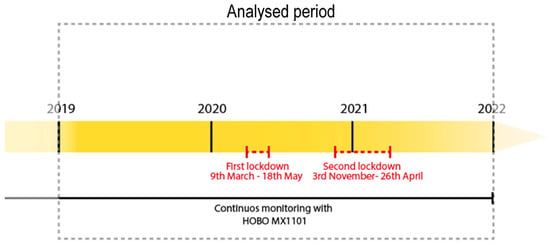
Figure 4.
A timeline with the main monitoring phases.
3.2. Methodology for Climatic Variation Assessment in Relation to the Number of Visitors
The total number of tourists who visit the interior space of the Cathedral daily was provided by the courtesy of the Veneranda Fabbrica del Duomo, through counting of the purchased tickets during the same years of monitoring.
Generally, in a pre-pandemic year (e.g., 2019), the number of tickets bought per year was more than 1,500,000 without considering the worshippers that generally enter a dedicated area to pray, which represents a negligible amount with respect to the number of tourists. In 2020 and 2021, due to the pandemic, the total amount of purchased tickets was much lower than in the previous year, particularly during the lockdown, when access to the Cathedral was prohibited and the number of tickets bought was null.
The Figure 5 shows the comparison of the average daily number of visitors for each month from 2019 to 2021. It is evident that in 2020, from the first lockdown entered into force by the Italian Government in March, the number of visitors has drastically decreased. Thereafter, from the end of May, the tickets started to be sold again, but limitedly and despite this regrowth, from November 2020 the Lombardy region passed into the Italian “red zones”, which lead to the closure of cultural spaces until April 2021. Finally, from May 2021, tourists began to steadily increase.
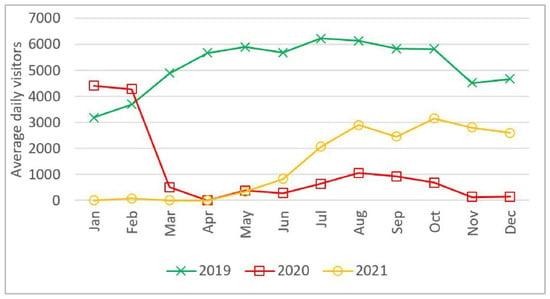
Figure 5.
Average daily number of tourists visiting Milan Cathedral each month over three years.
In such respect, the effect of people flux in the church has been analysed over the three mentioned years. In detail, the Normalized Diurnal Range index (NDR) [49,50] was adopted for the analysis of temperature daily fluctuations, since it allows assessment of the attenuation effect that the building envelope has on daily environmental variations.
In detail, NDR is defined as the ratio between the internal and the external temperature daily fluctuation difference. It should be noted that such index does not distinguish the effects of each involved parameter (i.e., the envelope capacity, solar radiation, ventilation, etc.), but it only considers their overall impact [50]. The NDR has been calculated through the following formula:
where:
- Ti,14 represents the daily indoor air temperature at 14:00;
- Ti,22 represents the daily indoor air temperature at 22:00;
- Te,14 represents the daily outdoor air temperature at 14:00;
- Te,22 represents the daily outdoor air temperature at 22:00.
The period between 14:00 and 22:00 has been considered as reference hours with high and low air temperatures in a day, according to [49,50]. In detail, if NDR is around zero, it means that the behaviour of the building is poorly affected by the external boundary conditions; thus, it has a high thermal capacity and low ventilation, while if NDR is close to unity, it means that the indoor and outdoor fluctuations are very similar. Such a condition can be experienced when there is persistence in the ventilation rate (e.g., due to consistent opening of windows) [50].
3.3. Risk Assessment Strategy for Material Conservation
As already introduced, several artworks are hosted inside the Milan Cathedral that need to be adequately preserved. A previous study carried out [42], focused on the risk assessment during an ordinary year for the conservation of three main categories of materials: wood, stone and metals. In this work, multiple years of monitoring data are analysed with different visitor influx conditions for the main material categories of the organs, which, among the noteworthy objects, are the most complex, susceptible and important in terms of conservation [45].
In such regard, the Performance Index (PI) proposed by Corgnati et al. [51] was adopted to evaluate the percentage of time (e.g., hours) with suitable hygrothermal conditions maintained for material conservation. The PI index is calculated through the following equation.
where n is the number of hours which fall into the T and RH suitable intervals for the artworks’ preservation according to standard UNI 10829 [7], while N represents the total number of hours in the monitoring campaign.
The standard UNI 10829 defines suitable T, RH and illuminance intervals for the proper preservation of over 30 categories of objects, including organic, inorganic and mixed materials [7]. For this specific work, the main categories of materials considered are reported hereafter:
- Polychrome wood carvings, painted wood, wooden clocks and wooden musical instruments, etc.;
- Paintings on canvas, oil paintings on canvas and canvas, tempera, gouaches;
- Leather or vellum;
- Metals with active corrosion.
For such categories, UNI 10829 provide T and RH intervals for proper conservation (Table 2). Where:

Table 2.
T and RH reference values for the conservation of the main categories of materials adopted.
- T0 and RH0 represents the recommended values for air temperature and relative humidity valid for the whole year;
- ΔTmax and ΔRHmax represent the maximum allowable daily excursion of air temperature and relative humidity.
4. Results and Discussion
In the following sections, the main results and discussion of the indoor climate data analyses are shown with respect to the effects of visitor influx.
4.1. Analysis of Long-Term Indoor Climate Monitoring
As described in Section 3.1, fixed dataloggers were installed in some accessible locations distributed inside the Cathedral.
In such regard, the differences in air temperature data among the dataloggers S3, S1 and S4 are smaller than 1 °C for most of the time during the year, with peaks during summer.
On the contrary, the data collected by dataloggers S2 and S6 generally record higher daily amplitude and increasingly lower temperatures over the year compared to S1, S3 and S4.
Lastly, the device S5 is directly connected to the outdoors by several holes, and thus is highly influenced by external air and solar radiation. Indeed, on some summer’s hot days, S5 detects up to 3 °C higher temperatures in comparison to the more internal dataloggers.
The data collected continuously by the six dataloggers for three years were compared below. In detail, the indoor temperatures range from 9.3 °C to 30.0 °C, from 10.5 °C to 29.4 °C and from 8.9 °C to 29.2 °C respectively for 2019, 2020 and 2021.
The smaller variability of the indoor condition with respect to the outdoors depends on the massive envelope that characterizes the case study. Furthermore, it was observed that during 2020, when the Cathedral openings were closed for a long period, the annual range of temperature is smaller with respect to the other years. Such an effect seems not to depend on the outdoor air conditions since the external range does not follow this trend (as shown in Figure 6).
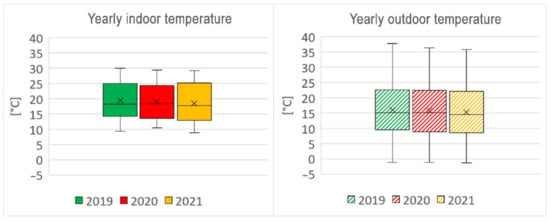
Figure 6.
Comparison between the internal and external temperatures for 2019, 2020 and 2021.
Regarding the relative humidity, it is shown in Figure 7 that 2020 was the year with the lowest RH values both indoors and outdoors. Furthermore, the maximum values reached outside were practically 100% (particularly when it rained); on the other hand, inside the Cathedral, thanks to the buffering capacity of the envelope and furnishings, the highest values of RH reached during the three years do not exceed the 90%.
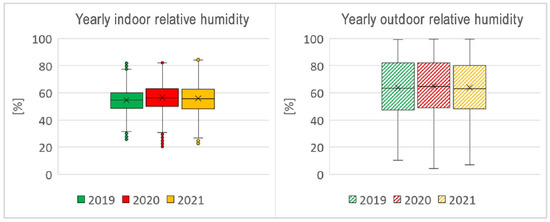
Figure 7.
Comparison between the internal and external relative humidity for 2019, 2020 and 2021.
A more detailed analysis of the effects of visitors on the indoor climate is shown in the following section.
4.2. Effects of Visitors Influx on the Indoor Climate
The impact of visitors inside the Cathedral has been evaluated considering two main effects: one direct, as the increasing temperature and humidity due to people’s presence and one undirect, related to the variation of airflow due to the opening of the doors.
4.2.1. Hygrothermal Contribution of Visitors
As stated in the introduction, internal heat and moisture gains due to people’s presence could be one of the main phenomena that affect the indoor climate of non-climatized buildings [42], according to the displacement and their numbers [41]. In particular, the most influenced areas are those close to the people, whereas in the surroundings the variations are lower [41].
In such respect, the environmental data were acquired during the Christmas celebration in 2019, when the entire Cathedral was occupied by the worshippers. During this event the presence of 800–1000 worshippers has been estimated, without considering people in the choir and at the altar.
In particular, as shown in Figure 8, an increase in air temperature of 0.64 °C has been recorded during the celebration in the zones of the Cathedral near the altar, while for the other areas, the increases were lower (e.g., 0.29 °C and 0.24 °C recorded from S4 and S6 respectively). Similarly, the indoor mixing ratio (i.e., the ratio of the mass of water vapor to the mass of dry air in a given volume) slightly increases during the ceremony due to the water vapour produced by people, even if the outdoor values remained approximately the same. On the contrary, indoor relative humidity data seems to follow the exterior condition before the event. However, particularly for datalogger S3, a decrease can be seen during the ceremony, caused by the temporary increase in indoor temperature due to the crowd presence.
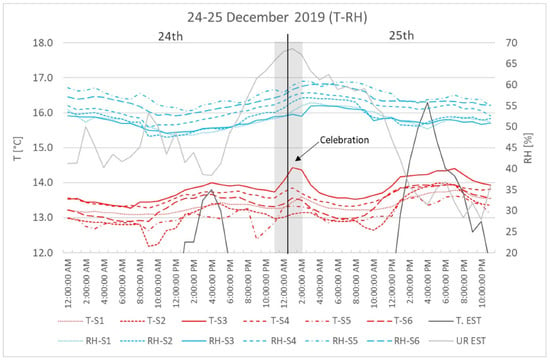
Figure 8.
Internal and external temperature and relative humidity values during 24–25 December 2019; the grey area indicates the celebration period.
A similar trend was also recorded in 2016 during some important events with considerable overcrowding, as described in previous work [42]. In this sense, from the monitoring of environmental data collected during a morning celebration, the presence of about 750 people lead to an increase in the indoor temperature of about 0.50 °C. After the event, when people went out of the church, the indoor temperature dropped, even if the external one was raising. A similar trend, with a lower magnitude, was observed in other events, characterized by a lower number of people [42].
From the analysis of the data collected, it can be observed that the presence of a huge number of visitors affects temporarily the indoor climate conditions of the Cathedral, starting from the spaces where they linger and then affecting the rest of the volume with a lower intensity. Such a slight increase in temperature and mixing ratio is mainly due to the enormous volume of the Cathedral. Moreover, the expected increase in relative humidity due to human vapour production is generally easily compensated for by the slight increase in air temperature.
4.2.2. Effects on the Air Change Rate
The second effect of people on the indoor climate of the Duomo di Milano is related to their interaction with doors, which might affect the air flow rate with the outdoors [35]. In such respect, the air change per hour (ACH) inside the Cathedral can be approximately evaluated through a graphical method comparing the indoor and outdoor mixing ratio peaks, as suggested by ASHRAE Guideline 34-2019: Energy Guideline for Historic Buildings [52].
In order to evaluate the effect of people on the indoor climate of the Cathedral, data were collected and compared for April 2019, 2020 and 2021. This month has been adopted because in 2020 and 2021, no tourists visited the Cathedral due to the pandemic, while in 2019, there was a normal visitor flux (see Figure 5 in Section 3.2).
In detail, in Figure 9 the ACH was estimated by counting the elapsed time (in hours) between the peak of the outdoor and indoor mixing ratio. The outdoor mixing ratio was obtained from ARPA meteorological station, while for the indoor mixing ratio, the data collected from datalogger S3 (which is in an area deep inside the cathedral and far from openings) were adopted.
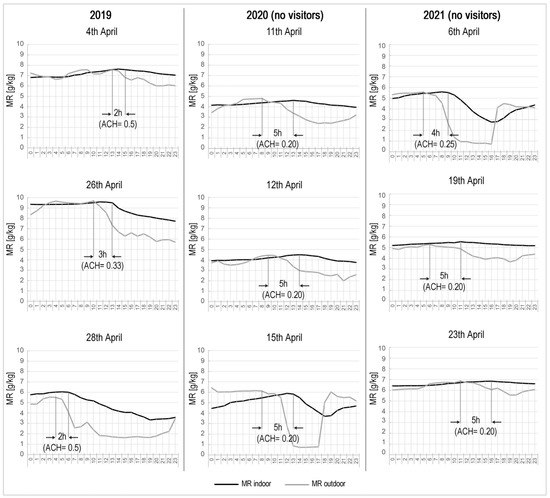
Figure 9.
Estimation of time elapsed between outdoor and indoor mixing ratio peaks for some sample days of April 2019, 2020 and 2021.
In Figure 9, some sample days are compared for the three years. According to the comparison, it can be noticed that in 2019, before the pandemic when a high number of people visited the Cathedral, the estimated ACH ranged between 0.33 and 0.5. While in 2020 and 2021, the ACH has been estimated between 0.17 and 0.25, reasonably due to the lower air exchange associated with the lack of visitors that interact with the doors or due to the doors being kept open to allow people to enter and exit.
From the comparison of the data, it can be stated that the average contribution of ACH due to the continuous doors opening is around 0.21–0.24.
Such ACH variation caused alterations in the indoor climate. In this regard, three reference months have been selected and compared over the three monitored years: March, April and May. Such months have been chosen because in 2020 and 2021, different lockdown periods affected the city of Milan, which caused the partial or complete absence of tourists inside the Cathedral with a consequence in the ACH alteration, while from 2019, a year before the pandemic, the indoor climate can be analysed with standard affluence.
In such respect, in Figure 10 the daily temperature maximum fluctuation for zones near the doors (data collected from datalogger S2), the area close to the altar and ancient organs (data collected from datalogger S3) and outdoors are compared.
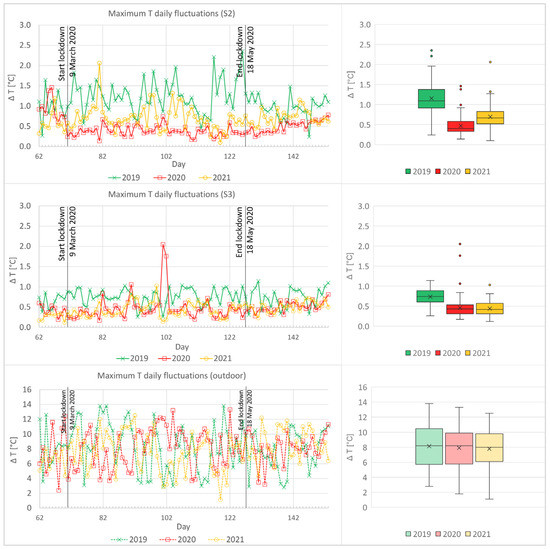
Figure 10.
Maximum daily T fluctuation in the area close to the doors (S2), close to the organs (S3) and outdoors.
From the comparison of the plots, it can be highlighted that the maximum temperatures daily fluctuation recorded during 2020 and 2021 are much lower compared to 2019. It should be noted that such behaviour does not depend on lower external daily fluctuations in 2020 and 2021, because the data over the three years are very similar (Figure 10), but mainly due to the lower air exchanges and to a lesser extent also to the lack of visitors heat and vapour contribution resulting from their absence. In detail, the mean value recorded in the area close to the doors, are about 1.16 °C, 0.47 °C and 0.70 °C respectively for 2019, 2020 and 2021, while in the spaces close to the altar and organs are 0.74 °C, 0.46 °C and 0.44 °C.
It should be noted that the reduction in the daily amplitude of temperature could lead to a reduction in the risks of deterioration for the artworks hosted inside the cathedral, as will be discussed in the following section.
Further confirmation of the reduction in interaction with the outdoors is given by the NDR index. As stated in Section 3.2, this index allows the evaluation of the attenuation effect that the building envelope could have on the daily indoor temperature. As can be seen from Figure 11 in 2020 and 2021 the NDR values are closer to zero, while in 2019 the NDR values are slightly higher, which means that the indoor environment is more affected by external conditions.
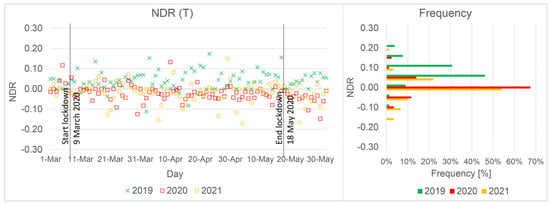
Figure 11.
Comparison of NDR for temperature (S3 datalogger) during March, April and May for the years 2019, 2020 and 2021.
The NDR was calculated and the number of values that fell in the interval from −0.1 to +0.1 were counted, which can be considered a very low range for buildings influenced by outdoor conditions, where the envelope cut off most of the largest outdoor thermal variability due to the thermal capacity and low air exchange rates [50]. It should be noted that negative values normally occur when the indoor air temperature is higher at 22:00 with respect to 14:00, due to the indoor T-peaks delay.
In particular, in 2019, 80% of NDR values fell in the above-mentioned range, while in 2020 and 2021 the percentage is about 98% and 96%, respectively. Moreover, the NDR calculated for the three reference months is equal to 0.054, −0.018 and −0.017 for 2019, 2020 and 2021, respectively. Such concentrated NDR around zero in 2020 and 2021 can be linked to the decrease in the air exchange rate.
4.2.3. Risk Assessment on the Main Materials Conservation
In this section, the effects on material conservation during the same reference months (March, April and May 2020) are analysed through the calculation of the Performance Index (PI) described in Section 3.3.
The categorisation of materials adopted in the analysis has been listed in Section 3.3, while the zone considered is the area where the organs are located (S3 sensor, Figure 1 and Figure 3).
In particular, based on the optimal ranges for T proposed by the standard UNI10829 (Section 3.3), the conservation conditions for paintings, wooden and leather objects are higher in 2020, since the PIT is about 26%, compared to 2019 and 2021, when the PI is low, respectively 9% and 8% as shown in the frequency distribution plots in Figure 12. A similar improvement was observed in the areas near the main doors (as shown in Figure A1 in the Appendix A). Such increases in the number of hours inside the conservation range mainly depend on the higher external temperature during April and May 2020 compared to the other years and allow a reduction in the rates of different deterioration mechanisms (chemical, biological and physical) [53].
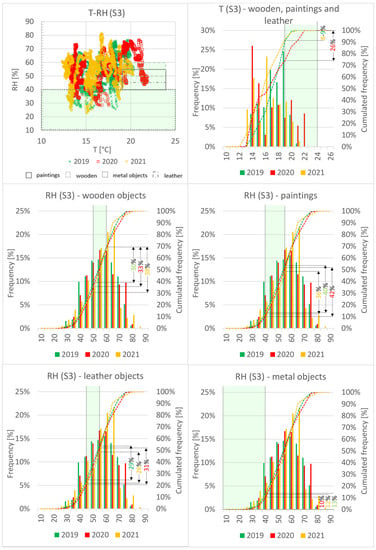
Figure 12.
Scatterplot and frequency distribution comparison of indoor climate data (datalogger S3) from March to May 2019, 2020 and 2021 with respect to the conservation range (the green area) proposed by UNI10829 for different materials.
Regarding relative humidity, the improvement recorded is about 2–3%; therefore, it can be considered negligible in 2020 for paintings, wood and leather objects with respect to 2019. Metal objects do not record an improvement in their conservation conditions.
The performance index was even calculated for the combined temperature and relative humidity parameters (PIT-RH). In such a respect, the estimated PIT-RH for wooden objects increased by 9% particularly in May 2020 with respect to 2019. In the same month, for paintings and leather material, the condition is even better, the PIT-RH calculated increased by 26% and 28% respectively for the two materials with respect to 2019. It should be noted that the main improvement depicted for the reference period is strongly connected to the more suitable external conditions for material conservation in 2020, enhanced by the prolonged closeness of the Cathedral’s openings.
On the other hand, another observed improvement which is strongly connected to the absence of visitors is the reduction in the temperature and relative humidity daily fluctuations (see Figure 13).
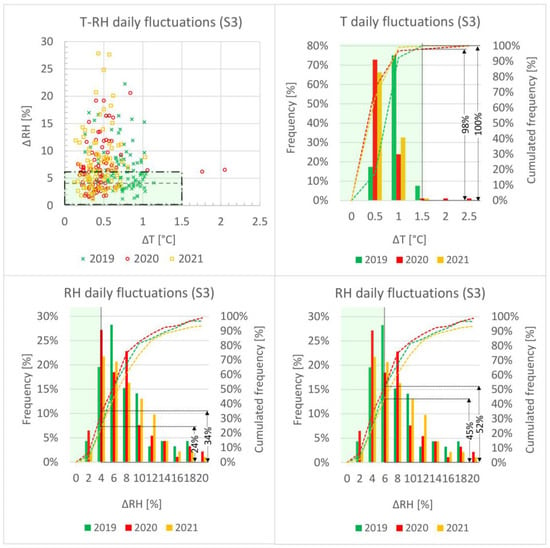
Figure 13.
Scatterplot and frequency distribution comparison of indoor climate data (datalogger S3) from March to May 2019, 2020 and 2021 concerning the daily conservation range (the green area) proposed by UNI10829.
Considering paintings, wood and leather objects, according to the calculated performance index PIT(daily), it has been observed that in 2020 and 2021, the index reached almost 100%, while in 2019, which was a year with normal visitor influx, the value is about 83%, especially in the areas close to the entrances (as shown in Figure A2 in the Appendix A). Such a reduction highlights how the related temperature deterioration due to rapid fluctuations can be consistently reduced when visitor flux is limited or well managed through controlled entries and a tightly sealed system of doors. Considering the areas close to the altar where the organs are located, for paintings, wooden and leather materials, from Figure 13, it can be seen that the PIT(daily) is higher than 98% for the three years.
Regarding daily relative humidity fluctuations, UNI10829 recommended limited daily fluctuation for paintings and artworks made of leather and wood (see Table 2 in Section 3.3) to reduce the risks of mechanical deterioration in hygroscopic materials, which can lead to cracks, fissures, deformations, etc.
In detail, for wooden objects, the PIRH(daily) for the reference period in 2020 is about 34%, while in 2019 and 2021 it remains at 24%. Such behaviour leads to a reduction in the risks of unacceptable irreversible physical change in wooden artefacts hosted inside the Cathedral.
For leather objects and paintings in 2020 and 2019, the PIRH(daily) is about 52%, while in 2021 it is 45%. Such improvement in the conservation conditions obtained can be particularly important for paintings hosted permanently (e.g., the panels of the organs) and temporarily inside the Cathedral (e.g., the paintings dedicated to San Carlo Borromeo, exhibited along the bays during November and December [54]).
5. Conclusions
In this study, the environmental data of one of the most important Cathedral in Italy were monitored continuously for three years (which include the lockdown period in Italy caused by the COVID-19 pandemic) to highlight how visitor influx affects the indoor climate of a huge volume and massive ancient building. It should be noted that Duomo di Milano is not provided by an air conditioning system, therefore, the indoor conditions depend mainly on the external climate and the activities carried out inside.
In detail, it was shown that the high thermal capacity of the Cathedral’s envelope leads to low daily cycles in temperature fluctuations and causes gradual and smooth changes throughout the seasons compared to the external conditions. From the comparison of the three years analysed, it was observed that particularly during 2020, the variability of the indoor temperature was smaller with respect to the other years, possibly caused by the prolonged closure of the building, while relative humidity follows mainly the outdoor variations with smoothness thanks to the buffering capacity of the Cathedral and furnishings contained within.
Considering the effects on the indoor climate of visitor influx and the conservation of most relevant materials hosted inside the Cathedral, this study has shown that:
- during the lockdown, characterized by practically null visitor influx, the daily temperature and relative humidity fluctuations are consistently reduced. In detail, the average daily temperature fluctuation in the area close to the doors decreased from 1.16 °C in 2019 to 0.47 °C in 2020, while in the zones close to the organs it decreased from 0.74 °C in 2019 to 0.46 °C in 2020. With regard to relative humidity, the daily amplitude even decreases, but with low intensity: the average amplitude close to the doors was 9.14% in 2019 and 7.34% in 2020, while in the inner area of the Cathedral it was 7.63% in 2019 and 6.62% in 2020;
- in a huge volume and massive building, people have a greater influence on the indoor climate through the increased air exchange with the outside caused by the interaction with opening doors, rather than their heat and vapour emissions on the environment;
- based on what was stated in the previous point, a worsening in the general conservation conditions caused by the visitor influx, with a special reference to hygroscopic materials (such as wooden, leather objects and paintings) has been detected, while for metal objects, no particular decrease in deterioration risks was recorded, since the optimal conservation conditions require very low relative humidity;
- daily fluctuations of temperature and relative humidity increase due to the higher air exchange with the outside caused by the interaction between visitors and doors. In such regard, the risks of deterioration related to the rapid fluctuations of relative humidity for leather, paintings and particularly for wooden materials have been increased by about 10–18% in the area close to the doors and 7–10% in the innermost zone. Regarding the daily fluctuation of temperature, in areas close to the doors, the risks are increased by about 27%, while in the innermost area, the optimal conservation conditions were reached in the three monitored years.
In conclusion, the adoption of strategies that allow the proper management of visitor influx in historic buildings is pivotal for their conservation; moreover, greater attention should be given also to the effect that people could have on the increase in air exchanges with the outside through the envelope openings. In particular, in spaces with huge volume, the latter aspect is a particularly influence; therefore, a solution such as a double-door system or compass doors might allow for a reduction in the air exchanges, particularly when the external conditions are harsh. Such aspects become of particular interest for buildings without an HVAC system in order to reduce risks of deterioration of their artworks. Future development of this research may consist in evaluating the impact of visitor influxes in different heritage buildings characterized by different dimensions, thermal capacity of the envelope and opening systems, through analysis and comparison of different case studies. Such work might highlight when indoor environments of historical buildings, which host valuable artworks, might be more affected by direct or indirect effects of visitor influx.
Author Contributions
H.E.H.-C.: Investigation, Resources, Data analysis, Writing. N.A.: Supervision, Methodology, Data analysis, Review & editing. C.D.P.: Conceptualization, Investigation, Methodology, Writing—review & editing. S.D.T.: Review & editing, Supervision. F.L.: Data curation, Investigation, Writing—original draft preparation. C.L.S.B.: Data curation, Formal analysis, Resources. All authors have read and agreed to the published version of the manuscript.
Funding
This research received funding from the Veneranda Fabbrica del Duomo di Milano in the context of the research program “Il Duomo di Milano: monitoraggio ambientale e valutazione dei rischi di degrade”.
Institutional Review Board Statement
Not applicable.
Informed Consent Statement
Not applicable.
Data Availability Statement
The data presented in this study are available on request from the corresponding author.
Acknowledgments
The authors gratefully acknowledge the Veneranda Fabbrica del Duomo di Milano for the assistance and information given.
Conflicts of Interest
The authors declare no conflict of interest.
Appendix A
Following, the analyses on the risks for materials conservation during the reference months (March, April and May 2020) are shown for datalogger S2, which was placed in an area close to the openings.
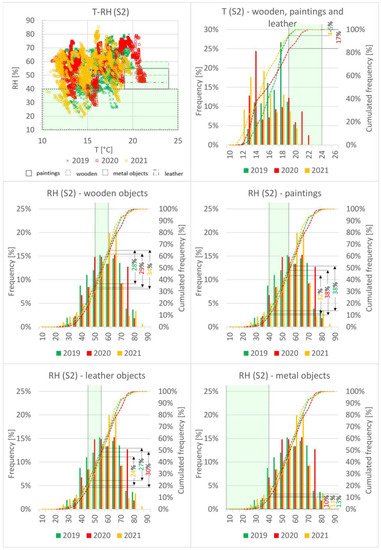
Figure A1.
Scatterplot and frequency distribution comparison of indoor climate data (datalogger S2) from March to May 2019, 2020 and 2021 with respect to the conservation range (the green area) proposed by UNI10829 for different materials.
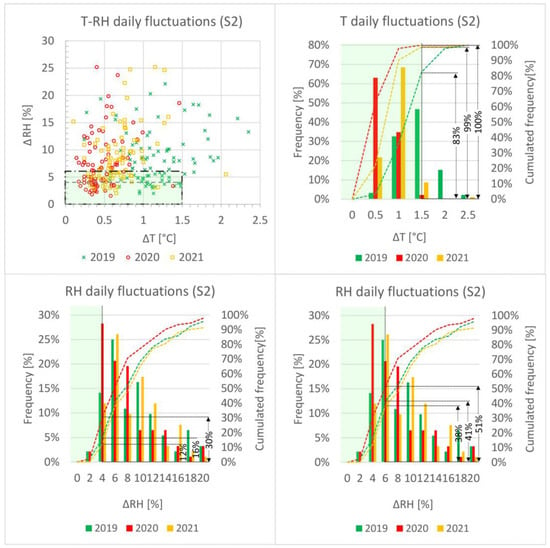
Figure A2.
Scatterplot and frequency distribution comparison of indoor climate data (datalogger S2) from March to May 2019, 2020 and 2021 concerning the daily conservation range (the green area) proposed by UNI10829.
References
- Napp, M.; Kalamees, T. Energy use and indoor climate of conservation heating, dehumidification and adaptive ventilation for the climate control of a mediaeval church in a cold climate. Energy Build. 2015, 108, 61–71. [Google Scholar] [CrossRef]
- Webb, A.L. Energy retrofits in historic and traditional buildings: A review of problems and methods. Renew. Sustain. Energy Rev. 2017, 77, 748–759. [Google Scholar] [CrossRef]
- United Nations. Transforming Our World: The 2030 Agenda for Sustainable Development; United Nations: New York, NY, USA, 2016. [Google Scholar]
- Gysels, K.; Delalieux, F.; Deutsch, F.; Van Grieken, R.; Camuffo, D.; Bernardi, A.; Sturaro, G.; Busse, H.J.; Wieser, M. Indoor environment and conservation in the Royal Museum of Fine Arts, Antwerp, Belgium. J. Cult. Herit. 2004, 5, 221–230. [Google Scholar] [CrossRef]
- Bonacina, C.; Baggio, P.; Cappelletti, F.; Stevan, A.G. The Scrovegni Chapel: The results of over 20 years of indoor climate monitoring. Energy Build. 2015, 95, 144–152. [Google Scholar] [CrossRef]
- Califano, A.; Baiesi, M.; Bertolin, C. Novel risk assessment tools for the climate-induced mechanical decay of wooden structures: Empirical and machine learning approaches. Forces Mech. 2022, 7, 100094. [Google Scholar] [CrossRef]
- UNI 10829; Beni di Interesse Storico e Artistico—Condizioni Ambientali di Conservazione—Misurazione ed Analisi. UNI: Rome, Italy, 1999; p. 24.
- ISO 19815; Management of the Environmental Conditions for Archive and Library Collections. International Organization for Standardization: Geneva, Switzerland, 2018.
- EN 16893; Conservation of Cultural Heritage. Specifications for Location, Construction and Modification of Buildings or Rooms Intended for the Storage or Use of Heritage Collections. British Standards Institute: Chiswick, UK, 2018.
- American Society of Heating Refrigerating and Air-Conditioning Engineers. ASHRAE Handbook—HVAC Applications, Chapter 24. Museums, Galleries, Archives and Libraries; American Society of Heating Refrigerating and Air-Conditioning Engineers: Washington, DC, USA, 2019. [Google Scholar]
- Silva, H.E.; Henriques, F.M.A. Preventive conservation of historic buildings in temperate climates. The importance of a risk-based analysis on the decision-making process. Energy Build. 2015, 107, 26–36. [Google Scholar] [CrossRef]
- Baglioni, P.; Giorgi, R.; Chelazzi, D. The degradation of wall paintings and stone: Specific ion effects. Curr. Opin. Colloid Interface Sci. 2016, 23, 66–71. [Google Scholar] [CrossRef]
- Walsh-Korbs, Z.; Avérous, L. Recent developments in the conservation of materials properties of historical wood. Prog. Mater. Sci. 2019, 102, 167–221. [Google Scholar] [CrossRef]
- Frasca, F.; Verticchio, E.; Caratelli, A.; Bertolin, C.; Camuffo, D.; Siani, A.M. A comprehensive study of the microclimate-induced conservation risks in hypogeal sites: The mithraeum of the baths of Caracalla (Rome). Sensors 2020, 20, 3310. [Google Scholar] [CrossRef]
- Natalia, R. Air pollution, black crusts and Cairo monuments: A review. In Proceedings of the 2020 IMEKO TC—4 International Conference on Metrology for Archaeology and Cultural Heritage, Trento, Italy, 22–24 October 2020; pp. 338–342. [Google Scholar]
- Camuffo, D.; Sturaro, G.; Valentino, A. Thermodynamic exchanges between the external boundary layer and the indoor microclimate at the Basilica of Santa Maria Maggiore, Rome, Italy: The problem of conservation of ancient works of art. Bound.-Layer Meteorol. 1999, 92, 243–262. [Google Scholar] [CrossRef]
- Camuffo, D.; Sturaro, G.; Valentino, A. The Conservation of Artworks and Hot Air Heating Systems in Churches: Are They Compatible? The Case of Rocca Pietore. Stud. Conserv. 1999, 44, 209–216. [Google Scholar]
- Mleczkowska, A.; Strojecki, M.; Bratasz, Ł.; Kozłowski, R. Particle penetration and deposition inside historical churches. Build. Environ. 2016, 95, 291–298. [Google Scholar] [CrossRef]
- Silva, H.E.; Henriques, F.M.A. The impact of tourism on the conservation and IAQ of cultural heritage: The case of the Monastery of Jerónimos (Portugal). Build. Environ. 2021, 190, 107536. [Google Scholar] [CrossRef]
- Varas-Muriel, M.J.; Fort, R.; Martínez-Garrido, M.I.; Zornoza-Indart, A.; López-Arce, P. Fluctuations in the indoor environment in Spanish rural churches and their effects on heritage conservation: Hygro-thermal and CO2conditions monitoring. Build. Environ. 2014, 82, 97–109. [Google Scholar] [CrossRef]
- Bucur, E.; Vasile, A.; Diodiu, R.; Catrangiu, A.; Petrescu, M. Assessment of indoor air quality in a wooden church for preventive conservation. J. Environ. Prot. Ecol. 2015, 16, 7–17. [Google Scholar]
- Istituto per i Beni Artistici-Culturali e Naturali della Regione Emilia Romagna. Oggetti Nel Tempo: PRINCIPI e Tecniche di Conservazione Preventiva; Clueb: Bologna, Italy, 2007; ISBN 9788849128666. [Google Scholar]
- Camuffo, D.; Van Grieken, R.; Busse, H.J.; Sturaro, G.; Valentino, A.; Bernardi, A.; Blades, N.; Shooter, D.; Gysels, K.; Deutsch, F.; et al. Environmental monitoring in four European museums. Atmos. Environ. 2001, 35, S127–S140. [Google Scholar] [CrossRef]
- ICOMOS. International cultural tourism charter-Managing Tourism at Places of Heritage Significance. Int. Counc. Monum. Sites 1999, 14, 1–9. [Google Scholar]
- Nawalany, G.; Sokołowski, P.; Michalik, M. Analysis of the operation of an unheated wooden church to the shaping of thermal and humidity conditions using the numerical method. Energies 2021, 14, 5200. [Google Scholar] [CrossRef]
- Muñoz-González, C.; Ruiz-Jaramillo, J.; Cuerdo-Vilches, T.; Joyanes-Díaz, M.D.; Vega, L.M.; Cano-Martos, V.; Navas-Martín, M.Á. Natural lighting in historic houses during times of pandemic. The case of housing in the mediterranean climate. Int. J. Environ. Res. Public Health 2021, 18, 7264. [Google Scholar] [CrossRef]
- Azzara, R.M.; Girardi, M.; Occhipinti, M.; Padovani, C.; Pellegrini, D.; Tanganelli, M. Structural Health Monitoring for Architectural Heritage: Case Studies in Central Italy. In European Workshop on Structural Health Monitoring, EWSHM; Lecture Notes in Civil Engineering; Springer: Berlin/Heidelberg, Germany, 2022; Volume 253, pp. 3–12. [Google Scholar]
- Saraiva, N.B.; Pereira, L.D.; Gaspar, A.R.; Costa, J.J. Measurement of particulate matter in a heritage building using optical counters: Long-term and spatial analyses. Sci. Total Environ. 2023, 862, 160747. [Google Scholar] [CrossRef]
- Intergovernmental Panel on Climate Change. Climate Change 2021: The Physical Science Basis; Cambridge University Press: Cambridge, UK, 2021. [Google Scholar]
- Baggio, P.; Bonacina, C.; Romagnoni, P.; Stevan, A.G. Microclimate analysis of the Scrovegni Chapel in Padua: Measurements and simulations. Stud. Conserv. 2004, 49, 161–176. [Google Scholar] [CrossRef]
- Merello, P.; García-Diego, F.J.; Beltrán, P.; Scatigno, C. High frequency data acquisition system for modelling the impact of visitors on the thermo-hygrometric conditions of archaeological sites: A Casa di Diana (Ostia Antica, Italy) case study. Sensors 2018, 18, 348. [Google Scholar] [CrossRef]
- Shchukina, T.V.; Drapalyuk, N.A.; Zherlykina, M.N.; Sheps, R.A. Influence on the Microclimate of the Number of People at Different Occupancy Temples. IOP Conf. Ser. Mater. Sci. Eng. 2020, 753, 052016. [Google Scholar] [CrossRef]
- Camuffo, D.; Pagan, E.; Bernardi, A.; Becherini, F. The impact of heating, lighting and people in re-using historical buildings: A case study. J. Cult. Herit. 2004, 5, 409–416. [Google Scholar] [CrossRef]
- Leissner, J.; Kilian, R.; Kotova, L.; Jacob, D.; Mikolajewicz, U.; Broström, T.; Ashley-Smith, J.; Schellen, H.L.; Martens, M.; Van Schijndel, J.; et al. Climate for culture: Assessing the impact of climate change on the future indoor climate in historic buildings using simulations. Herit. Sci. 2015, 3, 1–15. [Google Scholar] [CrossRef]
- Huerto-Cardenas, H.E.; Aste, N.; Del Pero, C.; Della Torre, S.; Leonforte, F. Effects of climate change on the future of heritage buildings: Case study and applied methodology. Climate 2021, 9, 132. [Google Scholar] [CrossRef]
- EN 15757:2010; Conservation of Cultural Property. Specifications for Temperature and Relative Humidity to Limit Climate-Induced Mechanical Damage in Organic Hygroscopic Materials. CEN: London, UK, 2010; p. 18.
- Brimblecombe, P.; Pachler, M.C.; Querner, P. Effect of indoor climate and habitat change on museum insects during Covid-19 closures. Heritage 2021, 4, 3497–3506. [Google Scholar] [CrossRef]
- Brimblecombe, P.; Querner, P. Changing Insect Catch in Viennese Museums during COVID-19. Heritage 2023, 6, 2809–2821. [Google Scholar] [CrossRef]
- Zaki, A.H.; Khalil, E.E.; Bialy, E.M.; Abdelmaksoud, W.A. Natural ventilation system versus air conditioning for temperature distribution in King Tutankhamuns’s gallery, egyptian museum. In Proceedings of the 53rd AIAA Aerospace Sciences Meeting, Kissimmee, FL, USA, 5–9 January 2015; pp. 1–8. [Google Scholar] [CrossRef]
- Balocco, C.; Petrone, G.; Cammarata, G. Numerical multi-physical approach for the assessment of coupled heat and moisture transfer combined with people movements in historical buildings. Build. Simul. 2014, 7, 289–303. [Google Scholar] [CrossRef]
- Varas-Muriel, M.J.; Fort, R. Microclimatic monitoring in an historic church fitted with modern heating: Implications for the preventive conservation of its cultural heritage. Build. Environ. 2018, 145, 290–307. [Google Scholar] [CrossRef]
- Aste, N.; Adhikari, R.S.; Buzzetti, M.; Della Torre, S.; Del Pero, C.; Leonforte, F. Microclimatic monitoring of the Duomo (Milan Cathedral): Risks-based analysis for the conservation of its cultural heritage. Build. Environ. 2019, 148, 240–257. [Google Scholar] [CrossRef]
- D’Amico, P. Duomo, nel Cuore del Maxi-Organo-Così si Accorda il Monumento. Available online: https://milano.corriere.it/notizie/cronaca/15_gennaio_04/duomo-cuore-maxi-organo-cosi-si-accorda-monumento-f6701062-93fc-11e4-8745-dbfbe9a3a0e4.shtml (accessed on 30 April 2022).
- Duomo di Milano l’Organo del Duomo. Available online: https://www.duomomilano.it/it/infopage/lorgano-del-duomo/10/ (accessed on 30 April 2022).
- Veneranda Fabbrica del Duomo di Milano. Il Grande Organo del Duomo di Milano: Un Capolavoro da Salvare; Veneranda Fabbrica del Duomo di Milano: Milan, Italy, 2019. [Google Scholar]
- Frasca, F.; Siani, A.M.; Casale, G.R.; Pedone, M.; Bratasz, Ł.; Strojecki, M.; Mleczkowska, A. Assessment of indoor climate of Mogiła Abbey in Kraków (Poland) and the application of the analogues method to predict microclimate indoor conditions. Environ. Sci. Pollut. Res. 2017, 24, 13895–13907. [Google Scholar] [CrossRef]
- Frasca, F.; Verticchio, E.; Merello, P.; Zarzo, M.; Grinde, A.; Fazio, E.; García-Diego, F.J.; Siani, A.M. A Statistical Approach for A-Posteriori Deployment of Microclimate Sensors in Museums: A Case Study. Sensors 2022, 22, 4547. [Google Scholar] [CrossRef]
- ARPA Richiesta Dati Misurati. Available online: https://www.arpalombardia.it/Pages/Meteorologia/Richiesta-dati-misurati.aspx (accessed on 17 January 2021).
- Camuffo, D.; della Valle, A.; Bertolin, C.; Santorelli, E. The Stancari air thermometer and the 1715–1737 record in Bologna, Italy. Clim. Change 2016, 139, 623–636. [Google Scholar] [CrossRef]
- Verticchio, E.; Frasca, F.; Bertolin, C.; Siani, A.M. Climate-induced risk for the preservation of paper collections: Comparative study among three historic libraries in Italy. Build. Environ. 2021, 206, 108394. [Google Scholar] [CrossRef]
- Corgnati, S.P.; Fabi, V.; Filippi, M. A methodology for microclimatic quality evaluation in museums: Application to a temporary exhibit. Build. Environ. 2008, 44, 1253–1260. [Google Scholar] [CrossRef]
- ASHRAE 34P; Energy Guideline for Historical Buildings. Standards Michigan: Ann Arbor, MI, USA, 2004.
- PAS 198:2012; Specification for Managing Environmental Conditions for Cultural Collections. The British Standards Institution: London, UK, 2012; p. 60.
- Duomo di Milano I Quadroni di San Carlo. Lo Straordinario Ciclo di Grandiosi Dipinti, Restaurati, per Conoscere la Storia e i Miracoli di Uno dei piu Importanti Santi della Cristianità. Available online: https://www.duomomilano.it/it/article/2020/11/03/i-quadroni-di-san-carlo/370/ (accessed on 1 May 2022).
Disclaimer/Publisher’s Note: The statements, opinions and data contained in all publications are solely those of the individual author(s) and contributor(s) and not of MDPI and/or the editor(s). MDPI and/or the editor(s) disclaim responsibility for any injury to people or property resulting from any ideas, methods, instructions or products referred to in the content. |
© 2023 by the authors. Licensee MDPI, Basel, Switzerland. This article is an open access article distributed under the terms and conditions of the Creative Commons Attribution (CC BY) license (https://creativecommons.org/licenses/by/4.0/).